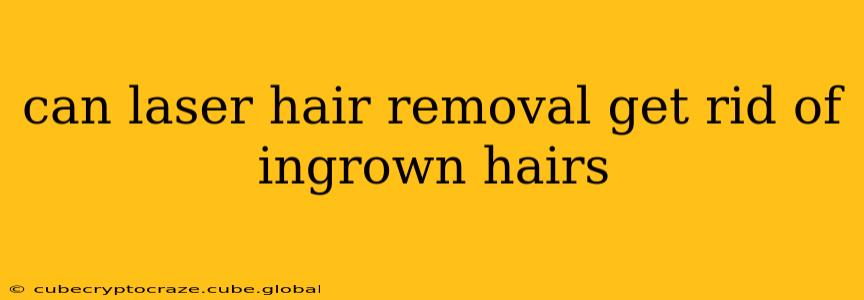Ingrown hairs are a common frustration, causing irritation, inflammation, and sometimes even scarring. Many people wonder if laser hair removal, a popular method for permanent hair reduction, can also address this pesky problem. The short answer is: it can help, but it's not a guaranteed cure. Let's delve deeper into the relationship between laser hair removal and ingrown hairs.
How Does Laser Hair Removal Work?
Before we discuss ingrown hairs, understanding how laser hair removal works is crucial. The process targets the melanin (pigment) in hair follicles using intense pulses of light. This heat energy damages the follicle, preventing future hair growth. The success of laser hair removal depends on several factors, including hair and skin type, hair density, and the skill of the technician.
Can Laser Hair Removal Prevent Ingrown Hairs?
Laser hair removal can significantly reduce the occurrence of ingrown hairs. By destroying the hair follicle, it eliminates the source of the problem—the hair that curls back into the skin. Fewer hairs mean fewer opportunities for ingrown hairs to develop. This is particularly true for those who suffer from frequent ingrown hairs due to coarse, curly hair. The smoother skin after treatment also reduces friction, a contributing factor to ingrown hairs.
Does Laser Hair Removal Get Rid of Existing Ingrown Hairs?
Laser hair removal itself won't directly treat existing ingrown hairs. It's preventative rather than curative for those already present. To address existing ingrown hairs, you'll need to use other methods like gentle exfoliation, warm compresses, or topical treatments to help the hair emerge from the skin. Attempting to remove an ingrown hair yourself can lead to infection or scarring, so it's best to consult a dermatologist for effective treatment.
How Long Does it Take to See Results?
The results of laser hair removal are gradual. You'll typically need multiple sessions spaced several weeks apart to achieve optimal results. The reduction in ingrown hairs will also be gradual, becoming increasingly noticeable with each session as fewer hairs grow back.
What are the Side Effects of Laser Hair Removal?
While generally safe, laser hair removal can have side effects, including redness, swelling, and temporary darkening or lightening of the skin. These side effects are usually temporary. More serious side effects are rare but can include scarring or changes in skin pigmentation. Choosing a qualified and experienced technician is crucial to minimize these risks.
Is Laser Hair Removal Right for Everyone?
Laser hair removal isn't suitable for everyone. Individuals with very dark skin or very light hair may not see significant results. People with certain medical conditions, such as active infections or skin diseases, should avoid this treatment. Always consult a dermatologist or a qualified medical professional to determine if laser hair removal is appropriate for you and to discuss potential risks and benefits.
What are Alternatives to Laser Hair Removal for Ingrown Hairs?
If you're looking for ways to deal with ingrown hairs without laser hair removal, there are several options:
- Exfoliation: Gently exfoliating the skin can help remove dead skin cells and free trapped hairs.
- Warm compresses: Applying warm compresses can soften the skin and help the ingrown hair emerge.
- Topical creams: Certain topical creams can help reduce inflammation and promote healing.
- Tweezers: Carefully removing the ingrown hair with clean tweezers can sometimes be helpful, but only if you can easily see the hair and are comfortable doing so. Avoid picking or squeezing.
In conclusion, while laser hair removal isn't a magic bullet for existing ingrown hairs, it's a highly effective method for reducing their occurrence in the long term. It's crucial to understand the process, potential side effects, and alternative treatment options before making a decision. Always consult a dermatologist or a qualified medical professional to discuss the best approach for your individual needs and skin type.
